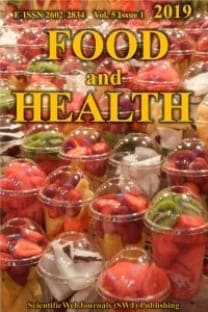In vitro risk assessment of Padina pavonica (Linnaeus) (Brown algae)
Padina pavonica (Linnaeus) Thivy 1960 is a brown algae that is antioxidant, antimicrobial, and anticancer effects and is generally used in soup, salad, and other dishes. However, no studies have been reported on safe consumption in humans to date. For this purpose, this study was conducted to determine the cytotoxic and genotoxic effects of P. pavonica on lymphocytes cultured from human blood. The water extract of P. pavonica was added into culture tubes at various concentrations (0.5-1000 μg/mL). Cytotoxic effects were determined by MTT assay. Antioxidant/oxidant status was evaluated by total antioxidant capacity (TAC) and total oxidative status (TOS) assays. Genotoxic effects were investigated by sister chromatid exchanges and micronucleus assays. Our results showed that P. pavonica had no genotoxic effects, even at higher concentrations. 1000 μg/mL concentration of P. pavonica caused an increase (P
___
Akremi, N., Cappoen, D., Anthonissen, R., Bouraoui, A., Verschaeve, L. (2016). Evaluation of the genotoxicity and cytotoxicity of semipurified fractions from the Mediterranean brown algae, Dictyopteris membranacea. Pharmacognosy Magazine, 12(Suppl 4), S395. https://doi.org/10.4103/0973-1296.188318Al-Enazi, N.M., Awaad, A.S., Zain, M.E., Alqasoumi, S.I. (2018). Antimicrobial, antioxidant and anticancer activities of Laurencia catarinensis, Laurencia majuscula and Padina pavonica extracts. Saudi Pharmaceutical Journal, 26(1), 44- 52. https://doi.org/10.1016/j.jsps.2017.11.001
Atmaca, H., İlhan, S., Batır, B., Pulat, Ç. Ç., Güner, A., Bektaş, H. (2020). Novel benzimidazole derivatives: Synthesis, in vitro cytotoxicity, apoptosis and cell cycle studies. Chemico-Biological Interactions, 109163. https://doi.org/10.1016/j.cbi.2020.109163
Bello, A., Padmanabhan, S., Thangamalai, R., Lakshmanan, K., Nagarajan, K. (2019). Evaluation of genotoxic effects of methanolic extract of brown seaweed Stoechospermum marginatum. The Journal of Phytopharmacology, 8(5), 226-231. https://doi.org/10.31254/phyto.2019.8504
Cherry, P., O'Hara, C., Magee, P.J., McSorley, E.M., Allsopp, P.J. (2019). Risks and benefits of consuming edible seaweeds. Nutrition Reviews, 77(5), 307-329. https://doi.org/10.1093/nutrit/nuy066
Das, B.C. (1988). Factors that influence formation of sister chromatid exchanges in human blood lymphocytes. CRC Critical Reviews in Toxicology, 19(1), 43-86. https://doi.org/10.3109/10408448809040817
Evans, H.J., O’Riordan, M.L. (1975). Human peripheral blood lymphocytes for the analysis of chromosome aberrations in mutagen tests. Mutation Research, 31, 135-148. https://doi.org/10.1016/0165-1161(75)90082-5
Field, C.B., Behrenfeld, M.J., Randerson, J.T., Falkowski, P. (1998). Primary production of the biosphere: integrating terrestrial and oceanic components. Science, 281, 237-240. https://doi.org/10.1126/science.281.5374.237
Fenech, M. (1993). The cytokinesis-block micronucleus technique: a detailed description of the method and its application to genotoxicity studies in human populations. Mutation Research, 285, 35-44. https://doi.org/10.1016/0027-5107(93)90049-L
Güner, A., Türkez, H., Aslan, A. (2012). The In Vitro Effects of Dermotocarpon Intestiniforme (A Lichen) Extracts Against Cadmium Induced Genetic and Oxidative Damage. Ekoloji. 21(84), 38-46. https://doi.org/10.5053/ekoloji.2012.845
Güner, A., Köksal, Ç., Erel, Ş.B., Kayalar, H., Nalbantsoy, A., Sukatar, A., Karabay Yavaşoğlu, N.Ü. (2015). Antimicrobial and antioxidant activities with acute toxicity, cytotoxicity and mutagenicity of Cystoseira compressa (Esper) Gerloff & Nizamuddin from the coast of Urla (Izmir, Turkey). Cytotechnology, 67, 135-143. https://doi.org/10.1007/s10616-013-9668-x
Güner, A., Karabay Yavasoğlu, N.U. (2018). Evaluation of antioxidant, antimicrobial and antimutagenic activity with irritation effects of Ceramium rubrum (Red Algae) extract. International Journal of Secondary Metabolite, 5, 279-287. https://doi.org/10.21448/ijsm.432654
Güner, A., Nalbantsoy, A., Sukatar, A., Karabay Yavaşoğlu, N.Ü. (2019). Apoptosis-inducing activities of Halopteris scoparia L. Sauvageau (brown algae) on cancer cells and its biosafety and antioxidant properties. Cytotechnology, 71(3), 687-704. https://doi.org/10.1007/s10616-019-00314-5
Güner, Ö., Güner, A., Yavaşoğlu, A., Karabay Yavaşoğlu, N.Ü., Kavlak, O. (2020). Ameliorative effect of edible Halopteris scoparia against cadmium-induced reproductive toxicity in male mice: A biochemical and histopathologic study. Andrologia, 52(6), e13591. https://doi.org/10.1111/and.13591
Khaled, N., Hiba, M., Asma, C. (2012). Antioxidant and Antifungal Activities of Padina pavonica and Sargassum vulgare from the Lebanese Mediterranean Coast. Advances in Environmental Biology, 6, 42-48.
Khanavi, M., Nabavi, M., Sadati, N., Shams Ardekani, M., Sohrabipour, J., Nabavi, S.M.B., Ghaeli P., Ostad, S.N. (2010). Cytotoxic activity of some marine brown algae against cancer cell lines. Biological Research, 43(1), 31-37. https://doi.org/10.4067/S0716-97602010000100005
Kim, K.J., Lee, O.H., Lee, B.Y. (2010). Genotoxicity studies on fucoidan from Sporophyll of Undaria pinnatifida. Food and Chemical Toxicology, 48(4), 1101-1104. https://doi.org/10.1016/j.fct.2010.01.032
Kusano, C., Ferrari, B. (2008). Total antioxidant capacity: a biomarker in biomedical and nutritional studies. Journal of Molecular Cell Biology, 7, 1-15.
Mashjoor, S., Yousefzadi, M., Esmaeili, M.A., Rafiee, R. (2016). Cytotoxicity and antimicrobial activity of marine macroalgae (Dictyotaceae and Ulvaceae) from the Persian Gulf. Cytotechnology, 68(5), 1717-1726. https://doi.org/10.1007/s10616-015-9921-6
McHugh, D.J. (2003). A guide to the seaweed industry. FAO Fish Tech Pap 441, Rome, Italy, p 105, ISBN 92-5-104958-0
Migliore, L., Nieri, M., Amodio, S., Loprieno, N. (1989). The human lymphocyte micronucleus assay: a comparison between whole-blood and separated-lymphocyte cultures. Mutation Research Letters, 227(3), 167-172. https://doi.org/10.1016/0165-7992(89)90041-9
Mohamed, S., Hashim, S.N., Rahman, H.A. (2012). Seaweeds: a sustainable functional food for complementary and alternative therapy. Trends in Food Science & Technology, 23, 83-96. https://doi.org/10.1016/j.tifs.2011.09.001
Pereira, L. (2016). Edible seaweeds of the world. CRC Press, Boca Raton, p 52. ISBN: 13:978-1-4987-3050-1 https://doi.org/10.1201/b19970
Roopashree, K.M., Naik, D. (2019). Advanced method of secondary metabolite extraction and quality analysis. Journal of Pharmacognosy and Phytochemistry, 8(3), 1829-1842.
Song, M.Y., Ku, S.K., Han, J.S. (2012). Genotoxicity testing of low molecular weight fucoidan from brown seaweeds. Food and Chemical Toxicology, 50(3-4), 790-796. https://doi.org/10.1016/j.fct.2011.11.010
Stanojkovic, T.P., Savikin, K., Zdunic, G., Kljajic, Z., Grozdanic, N., Antic, J. (2013). In Vitro Antitumoral Activities of Padina pavonica on Human Cervix and Breast Cancer Cell Lines. Journal of Medicinal Plants Research, 7, 419- 424.
- ISSN: 2602-2834
- Yayın Aralığı: Yılda 4 Sayı
- Başlangıç: 2018
- Yayıncı: ScientificWebJournals (SWJ) Özkan Özden
Sayıdaki Diğer Makaleler
In vitro risk assessment of Padina pavonica (Linnaeus) (Brown algae)
Afyonkarahisar’da satışa sunulan kıymalarda Aeromonas spp. varlığının araştırılması
RECEP KARA, ULAŞ ACARÖZ, Zeki GÜRLER, Fahriye ZEMHERİ NAVRUZ, Ali SOYLU
Curcumin's antioxidant effects on inflammatory diseases
Curcumin's antioxidant effects on inflammatory diseases
A potential antiviral and food-derived healthy ingredient: Resveratrol
Burcu İrem OMURTAG KORKMAZ, Ayça AYDIN, Neşe KILIÇ
Nazlı SÖYLER, Mehmet Sedat İPAR, DEMET KOCATEPE
